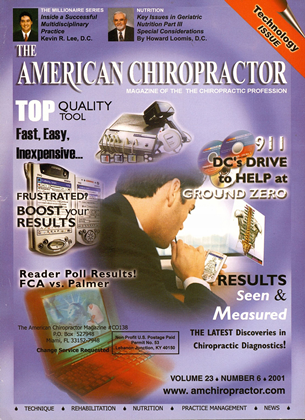Today's modern practice has an easily accessible and inexpensive tool available to it the Internet. The "information superhighway" provides numerous potential services to providers, including access to medical research results, email, medical news and product release data, training and online seminars, computer and software support, electronic claims transmissions and payment responses, and much, much more. Major medical research centers provide access to their research activities and results via the web. Some of the more popular sites include the Mayo Clinic and the University of PA Hospital. Huge databases of case histories and diagnosis assistance are frequently available online to any qualified provider. Most of the popular chiropractic groups, organizations, and publishers have web sites. Doctors can visit these sites at their leisure to learn about a variety of topics, including new products, medical advances, shows and conventions, and seminars. Many forward thinking insurance carriers and electronic claims clearing houses have discovered the efficiency and cost effectiveness of using the Internet to collect electronic claims submissions from their providers. Participating providers can simply upload their NSF or ANSI 837 compatible insurance billing data to the carriers' web sites anytime (24 hours a day) that they wish, and the carriers or clearing houses, typically, post a response/results file for the provider on the same web site-usually within a few hours of the actual billing transmission. No special modem connections arc required. No toll charges. All that is needed is an Internet connection. Carriers are not the only ones to recognize the Web's potential as a support and information vehicle. Chiropractic software vendors have discovered the power of the Internet as a tool for providing im- mediate and top quality support, and for training their users. Many software developers now provide the ability for their clinics to: • Download upgrades and patches to their products; •Participate in online discussion groups with other users of these products; •View or download documentation, user's guides, and FAQ's (frequently asked questions); Use their Internet connection as a high speed, real-time training vehicle; Receive technical support; and down load free trial versions of new features and new products. Recently, a few companies have been attempting to take the use of the Internet for software products in chiropractic one step further by becoming Application Service Providers (ASP's) who provide their clients with an entire billing, medical records, or similar application. Basically, ASP's house both the clinic's data and the practice management software required to do billing, etc., and they charge the clinic a monthly fee for this turnkey service. All the programs for the various software applications are owned and operated on a web server by the ASP vendor. About 18 months ago, venture capitalists and some software companies were convinced that everyone would jump on the ASP bandwagon. However, to-date, this concept is far from becoming a runaway success. The idea sounds great at first. No more worrying about training staff or keeping up with operating system and other software maintenance and support activities. The advantages to the vendor arc signifi- cant-locked in users (they have your data!). Instead of selling clinics a single software system, they collect an annuity from each clinic each and every month. They have access to your data and can use, rent, or sell that data for various purposes (unless their contracts specifically prohibit this). In the long term, ASP's may well be a viable alternative to purchasing and running your own software. At this point in time, however, there are a few glitches from the user's point of view: The issue of who owns the data can quickly become a significant legal prob lem. It came from your clinic, but it is on the vendor's computer on the Internet; Security is probably the largest con- cern. Your data is living on a server somewhere on the Internet, where it is potentially accessible by anyone smart enough to hack into that server; •Limited flexibility—You do not have either the programs or the data on your own computers, so you are restricted as to how and when you can use your data; • Lack of the availability of high-speed broadband Internet access in many areas of the country. With normal modem access, working with your ASP can be painfully slow! The Internet is changing the way all of us in the software business do business. Will it get to the point where we do everything for our users via an Internet web server? Perhaps. But we are not there yet! Don Biresch is President and founder ofDB Consultants, Inc., a practice management software development and publishing company based in Bucks County, PA. For more information, call (610) 847-5065. (www, dbconsultants. com)
 View Full Issue
View Full Issue












